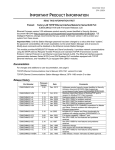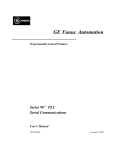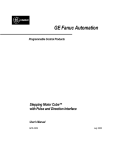Download Series 90-30 Programmable Controller Troubleshooting
Transcript
| | | Î GE GE Fanuc Automation Intelligent Platforms Programmable Control Products Î GE Intelligent Platforms Information Centers GE Fanuc Automation Americas: 1 800 433 2682 or 434 978 5100 www.ge-ip.com P.O. Box 8106 Global regional phone numbers are listed by location on Charlottesville, VA 22906 our web site at www.ge-ip.com/contact ©2010 GE Intelligent Platforms, Inc. GFZ–0085 All rights reserved. |__ *Trademark of __|__ GE Intelligent Platforms, Inc. All other brands or names are property of their respective holders. Series 90 TM–30 Programmable Controller Troubleshooting Guide __| | | Î | GE Fanuc Automation Programmable Control Products Series 90 TM–30 Programmable Controller Troubleshooting Guide GFZ–0085 |__ September 2010 August 1993 __|__ __| | | This document is based on information available at the time of its publication. While efforts have been made to be accurate, the information contained in this document does not purport to cover all details or variations in hardware and software, nor to provide for every contingency in connection with installation, operation and maintenance. This document may describe features not present in all hardware and software systems. GE Intelligent Platforms assumes no obligation of notice to holders of this document with respect to changes subsequently made. GE Intelligent Platforms makes no representation or warranty, expressed, implied, or statutory with respect to, and assumes no responsibility for the accuracy, completeness or usefulness of the information contained in this document. No warranties of merchantability of fitness for purpose shall apply. The following are trademarks of GE Intelligent Platforms, Inc. ÁÁÁÁÁÁÁ ÁÁÁÁÁÁÁÁ ÁÁÁÁÁ ÁÁÁÁÁÁÁ ÁÁÁÁÁÁÁÁ ÁÁÁÁÁ ÁÁÁÁÁÁÁ ÁÁÁÁÁÁÁÁ ÁÁÁÁÁ ÁÁÁÁÁÁÁ ÁÁÁÁÁÁÁÁ ÁÁÁÁÁ ÁÁÁÁÁÁÁ ÁÁÁÁÁÁÁÁ ÁÁÁÁÁ ÁÁÁÁÁÁÁ ÁÁÁÁÁÁÁÁ ÁÁÁÁÁ Alarm Master PROMACRO GEnet Series 90 Modelmaster ProLoop Workmaster CIMSTAR Series Six Logicmaster CIMPLICITY 90–ADS Series Three CIMPLICITY PowerTRAC Genius Power TRAC Helpmate CIMPLICITY Series One Genius VuMaster Series Five | Stand clear of controlled equipment when power is applied. If the problem is intermittent, sudden unexpected machine motion could occur, causing injury. Also reference NFPA 70E Part II for additional guidelines for safety practices. Never reach into a machine to operate a switch since unexpected motion could occur, causing injury. Remove all electrical power at the Main Power Disconnect to ensure total power removal. 1993 - 2010 Copyright 1993 GE Fanuc Automation North America, Inc. Always remove power before inserting or removing modules, or before connecting I/O cabling. All Rights Reserved. |__ __|__ __| | | This guide describes a logical sequence for troubleshooting your Series 90–30 programmable controller. It includes the procedure for changing or adding a EPROM or EEPROM to your CPU. The Series 90–30 PLC is a member of the Series 90TM family of programmable logic controllers. This is the first release of this Troubleshooting Guide. Included are models CPU 311, 313, 321, 323, 331 and 341. | At GE Intelligent Platforms, we strive to produce quality technical documentation. After you have used this troubleshooting guide, please take a few moments to write us with your comments and suggestions. Our address is: Manager Technical Publications, GE Fanuc Automation. PO Box 8106, Charlottesville, VA 22906 Drake C. Fink Sr. Staff Systems Engineer Series 90 TM–30 Programmable Controller Installation Manual (GFK–0356). Series 90 TM–30 and 90–20 PLC Hand–Held Programmer User’s Manual (GFK–0402) Logicmaster TM 90 Series 90–30 and 90–20 Programming Software User’s Manual (GFK–0466) Series 90 TM–30/90–20 Programmable Controllers Reference Manual (GFK–0467) |__ __|__ __| | | | |__ __|__ __| 8. Application programs are normally developed in the CPU’s RAM memory and executed from RAM memory. If additional program integrity is desired, or operation of the PLC without a battery is desired, an optional EEPROM or EPROM can be installed in a spare socket (labeled PROGRAM PROM) on the Model 311/313 backplane or in a socket on the model 331/341 CPU module. EEPROMs can be written to and read from. EPROMs can be read when installed in the PLC; however, they must be written to using an external PROM programming device. 9. |__ __|__ Following is the procedure for adding or changing the EEPROM or EPROM. For clarity, the term PROM is used to refer to either an EEPROM or an EPROM. 1. Remove power from the system. 2. If 311/313 D D 3. D D Remove all modules, including the power supply. Remove the plastic cover. If 331/341: Remove CPU from backplane. Remove front plate and bezel. Unsnap circuit board and remove from case. 4. If the socket is the type which has a screw near the top edge (some versions of 311/331), loosen screw at top of PROM socket (CCW twist;). 5. If present, remove old PROM from socket. Replace with or install new PROM. Orient the PROM so the end with a notch (the top of the prom) is toward the top edge of the backplane. Pin 1 of the prom is the first pin on the left as you move counter–clockwise from the notch. On the 311/331, correct installation orients the notch toward the screw. 6. When present, tighten screw at top of PROM socket (CW twist). 7. If 311/313: D D Replace the plastic cover. Replace all modules, including the power supply. D D D D If 331 CPU: __| Assure jumper JP1, located at the bottom of the PROM socket, is in the 1–2 position for EPROM and the 3–2 position for EEPROM. This informs the CPU firmware which type of device is present. If 331/341 CPU: Replace circuit board in case. Reinstall front plate and bezel. Replace CPU in backplane. |__ __|__ 10. Apply power. The PLC follows the flowchart found in the ”Power–Up Sequence” figure in the Power–Up and Power–Down Section of the Series 90–30/90–20 Programmable Controllers Reference Manual (GFK–0467) to determine if a program will be loaded from PROM to RAM. 11. For the EEPROM to be used by the CPU, the CPU configuration must be set to use EEPROM as the ”Program Source”. You may use the LM90 Configuration software or the HHP to accomplish this. 12. To store the program in RAM, you may use either the Hand–Held Programmer or Logicmaster 90–30, Rev 3.5 or higher. Refer to the instructions in the HHP User’s Manual (GFK–0402) for HHP. To use Logicmaster 90–30, follow these instructions: D D D D Start the LM90–30 Programmer Package D Verify the items you want to write to EEPROM are selected. D Press ENTER to start the operation. Refer to the Logicmaster 90 Series 90–30 and 90–20 Programming Software User’s Manual (GFK–0466) for more information. Activate the Utilities Menu (F9) Select the EEPROM function (F10) Select the WRITE operation __| |__ __|__ __| 1. WARNING: Do not discard the lithium–manganese dioxide battery in fire. Do not attempt to discharge the battery. The battery may burst or burn or release hazardous materials. Dispose of the battery as you would any hazardous material. 2. CAUTION: After a power fault, the system will come back on in the mode (STOP, RUN/ ENABLED, RUN/DISABLED) in which it was operating before power loss, unless the power up configuration specifies a particular mode. 3. Not having a battery installed will not prevent the PLC from running. It will generate a PLC fault on power cycle that prevents the PLC from entering RUN mode automatically. Clearing this fault will enable the PLC to be placed in RUN mode. 4. To short the ’super cap’ on a 311/321 PLC: D D D D Remove power from the system. D D D Replace the plastic face plate. 5. Supply (input) voltage tolerances for Series 90–30 power supplies: IC693PWR321: 100 to 240 VAC 100 to 250 VDC (125 VDC nominal) IC693PWR322: 18 to 56 VDC, 21 VDC minimum to start 24 VDC OR 48 VDC nominal Remove all modules, including the power supply. Remove the plastic face plate. Find component C20 along the left edge of the module. This is the ’super cap’. Short the positive (+) and negative (–) leads of this device. Replace all modules. Restore power to the system. 6. Total cable length must not exceed 50 feet between a CPU rack and an expansion rack. Length must not exceed 700 feet between a CPU rack and a remote rack. No termination plug is needed on a one–rack system. |__ __|__ " " "#!# &! '" "#' ÁÁ ÁÁ " '" ##!' ) %!' ! ÁÁ Á !"# # $ Á Á # $ # !$ $" " ) ! ! "# '" ) # '" __| !$ ! Á '" " &'" " '" !$ Á " "'"# !# Á Á Á '" ! "% Á Á Á Á (* |__ __|__ __| |__ __|__ __| |__ __|__ __| # #" %" &! ! # !"" !% % !"" # !" &! #! " % " # # # &! ! #" !&! !" #! " ! # #" "! &! &! &! ! !&!" " !" " !$ |__ __|__ #) )$ ! $%#% "& __| " ! "& )$ ! * #!' "!(# * #!' "& * #!' #" $)$% "#! * #" "& * "") "!(# $%#% " ! $%#% %$ % ! % %$ ! % "&$ !#) #$%!#$ !& %! "#%#$ & #% "#%) % %! %# &% '&$ * #!' "!(# * #!' #$ " !'# * $!#% $&"# " $ !% * #" #$ " !'# * "") "!(# $%#% " |__ __|__ " __| #% " ! % &# $ " &% $ ! " & ! !! & ! " "! $! & #! " ! " ! & " $ $ $! ! " & # % " # ! !! !% ! % & #% " $ $ $! ! % " "! $! !! |__ __|__ __| ! % $ " $ % # % % % % " $ |__ __|__ __| # #" '! ) !" #""! %" # " ) !" ) !" # ) !" " " " '! $ ' ) ! ) ! !# ' ' # ) !" " #! " !! ! ' # " ) ! " & & " ! " '! !$ '! ! !'!" " ! # $ ' #"! $! "! #"#"! ( !" " |__ __|__ __| % ! " % " $ % $ " $ $ $ " % ! " % ! % $ " $ ! " $ " # $ $ |__ __|__ __| " " " ! " " ! ! ! ! ! ! !




























